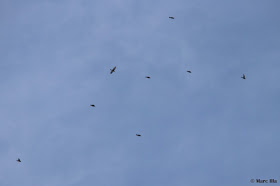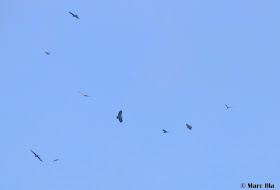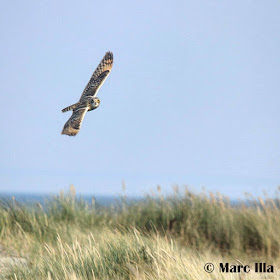During the autumn of 2017, 3023 birds of 45 species have been ringed in the standardised ringing at the Flommen reedbeds, far below the reference number of 4258 birds (average 1980-2009).
Click here to check the seasonal total at Flommen for this year.

Contrary, for instance, to the previous year (2016), from the beginning of the season it was noticeable the low density and bad growth of the reedbed, probably due to the cold and late spring that affected most of Scandinavia. This had also an apparent effect on the breeding birds, translated into late breeding of the local species, such as Eurasian Reed Warblers (Acrocephalus scirpaceus) with chicks fledging as far as late August, and also Reed Buntings (Emberiza schoeniclus) with fledglings during mid-August, also slightly later than usual. The bad breeding season had direct effects on the seasonal totals, with the Penduline Tit (Remiz pendulinus) being a good example: only 4 individuals were ringed (average: 18), very likely as a consequence of the bad breeding season in Southern Sweden (Peter Öhrström com.pers.). But this effect is also seen in the numbers of Reed Warblers (A.scirpaceus) and Willow Warblers (Phylloscopus trochilus), species in which the juvenile peak migration, which is usually very strong and produces a lot of captures, was very diluted in numbers and almost unnoticeable through the season.
During the first days of the season in late July and most of August, the weather has been quite unpredictable, with almost daily rain showers and several windy days that probably lowered slightly the amount of trapped birds through the season.
In order, the most common species this season have been Reed Warbler (Acrocephalus scirpaceus) with 1061 individuals ringed, Sedge Warbler (Acrocephalus schoenobaenus) with 750, Reed Bunting (Emberiza schoeniclus) with 202, Barn Swallow (Hirundo rustica) with 180, Willow Warbler (Phylloscopus trochilus) with 149 and Sand Martin (Riparia riparia) with 143.
As it is already a clear trend in the last years of the standardised ringing at Flommen, Reed Warblers keep a clear tendency below the average (seasonal total: 1061, average: 1940), as well as Willow Warblers (seasonal total: 149, average: 628). As it was mentioned above, the apparent bad breeding season for this species has clearly affected this season’s numbers, especially in the case of the Willow Warbler. Due to the late breeding season, the adult peak migration passage for the common Acrocephalus Warblers, Reed Warbler (A.scirpaceus) and Sedge Warbler (A.schoenobaenus), has also been slightly delayed. On these species, adults migrate first than the juveniles, and some years the peak passage of adults has apparently already passed by the time the season starts the 21st of July. That is especially the case of the Sedge Warbler, and this year’s late breeding is clearly reflected in the big amount of adults trapped in the beginning of the season. The seasonal total for the Sedge Warbler is 750 ringed individuals, above the average reference number of 588, probably due to the unusual amount of adults. On the other hand, the numbers of Marsh Warbler (Acrocephalus palustris) were quite low this season, both for adults and first-years (seasonal total: 68, average: 92).
 |
| Juvenile (left) and adult (right) Reed Warblers. |
The absence of Blue Tit (Cyanistes caeruleus) invasion this year is also affecting the seasonal total number at Flommen, since 4 birds were ringed when the average is 80. After the relatively calm August due to few juveniles (bad breeding season), September had very few good days in terms of amount of nocturnal migrants landing in the peninsula, and thus the numbers of the regular September species were generally lower than the average reference number. As examples: Robin (Erithacus rubecula) (seasonal total: 56, average: 75), Dunnock (Prunella modularis) (seasonal total: 25, average: 54) and Winter Wren (Troglodytes troglodytes) (seasonal total: 43, average: 40).
On the other hand, it is worth mentioning the good numbers for Barn Swallow (Hirundo rustica) (seasonal total: 180, average: 140), Sand Martin (Riparia riparia) (seasonal total: 143, average: 43) and White Wagtail (Motacilla alba) (seasonal total: 22, average: 12); three species which their numbers depend quite much on the formation of a roosting site in the study area, that was present this year daily during the beginning of the season.

Other typical migrants ringed at the Flommen reedbeds showed good numbers compared to the average 1980-2009, such as Tree Pipit (Anthus trivialis) (seasonal total: 33, average: 25), Common Whitethroat (Sylvia communis) (seasonal total: 37, average: 34), Red-backed Shrike (Lanius collurio) (seasonal total: 11, average: 8), Whinchat (Saxicola rubetra) (seasonal total: 51, average: 51) and Reed Bunting (Emberiza schoeniclus) (seasonal total: 202, average: 212). The case with the Chiffchaffs (Phylloscopus collybita) is interesting: the species has increased a lot the recent years and it is now far over the average (seasonal total: 98, average: 14).

Interesting local breeding birds such as Bearded Reedlings (Panurus biarmicus) bred again in the area (they were common breeding species in the past, but had disappeared for several years until they returned in 2015), and at least 2 pairs were detected. From the ringing data we obtained, both females in both pairs had a successful second clutch in August. In total, 13 juveniles were ringed through the season. Interestingly, at least two female Marsh Warblers (Acrocephalus palustris) were caught in the beginning of the season with broodpatches, and afterwards some fledglings confirmed the breeding of at least 2 pairs in the northern part of the reedbeds. Water Rails (Rallus aquaticus), as many other species as mentioned above, had also a delayed breeding season. 18 individuals were ringed at Flommen, 2 in the standardised ringing and 16 in extra ringing, using metal cages. During the last few seasons there has been an extra effort to ring local breeding Water Rails with quite good results, and although more work is needed, it is interesting to mention that we have no data corresponding to any returning individual (adult or juvenile) to the breeding sites.

Six foreign recoveries were caught during the season, two Sedge Warblers – one from Latvia and the other from France -, and 4 Reed Warblers – one from France, two from Belgium and 1 from Denmark. 27 individuals were caught from other ringing stations in Sweden: 11 Reed Warblers, 6 Sedge Warblers, 4 Barn Swallows, 4 Penduline Tits, 1 Sand Martin and 1 Reed Bunting.
Among the rare or scarcely captured species this season, there was the 6th Savi’s Warbler (Locustella luscinioides) ringed for the Bird Observatory (5th at Flommen), the first ever Firecrest (Regulus ignicapilla) to be ringed at Flommen (consequence of the increasing tendency of the species in Southern Sweden), a Great Reed Warbler (Acrocephalus arundinaceus) (58th at Flommen since 1980), a Bluethroat (Luscinia svecica) (51st at Flommen since 1980), a Wryneck (Jynx torquilla) (29th in standardised ringing at Flommen since 1980), 2 Common Grasshopper Warblers (Locustella naevia), 2 Jack Snipes (Lymnocryptes minimus) (12th and 13th in standardised ringing at Flommen) and 9 Spotted Crakes (Porzana porzana) (2 in the standardised ringing and 7 more in extra ringing in the area).

In extra ringing at the same place, 258 birds were ringed including the mentioned amounts of Water Rails (16) and Spotted Crakes (7), 1 Moorhen (Gallinula chloropus), 2 Coots (Fulica atra), 9 Mallards (Anas platyrhynchos), 2 Little Grebes (Tachybaptus ruficollus), 12 Sparrowhawks (Accipiter nisus), 2 Common Kestrels (Falco tinnunculus), 2 Short-eared Owls (Asio flammeus), 2 Common Snipes (Gallinago gallinago), 2 Green Sandpipers (Tringa ochropus), 1 Wood Sandpiper (Tringa glareola), 1 Skyark (Alauda arvensis), 25 Meadow Pipits (Anthus pratensis) and 9 Rock Pipits (Anthus petrosus).
 |
| The "Flommen combo"! Picture by Harald Ris. |
Ringers that worked on the reedbed with me were, listed by arrival date: Timmy Micallef, Per Andell, Ingela Källén, Emil Lundahl, Alex Zackrisson, Tore Dahlberg and Harald Ris. And, of course, big TACK to the rest of the Falsterbo Bird Observatory crew for another great season!

























































